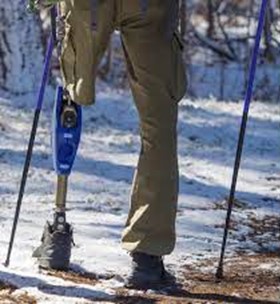Written By: Vern Swanson, PT, DPT, Ph.D., NCS
Navigating Snow and Ice for Lower Extremity (LE) Amputees: Essential Safety Tips for Winter Ambulation
As winter approaches, the magic of snow-covered landscapes and icy wonderlands can also present challenges for lower extremity (LE) amputees when it comes to ambulating safely. Navigating snow and ice requires extra caution, especially for those with limb loss. However, with the right knowledge, preparation, and adaptive strategies, LE amputees can reduce their fall risk and enjoy the winter season to the fullest. Here are six essential safety tips tailored for navigating snow and ice for LE amputees, each accompanied by additional details and insights to enhance safety and comfort during the winter season:
 #1 Invest in High-Quality Winter Boots: Choosing the right winter boots is crucial for safe and comfortable ambulation in snow and ice. Insulated, waterproof boots with exceptional traction are essential. Look for boots that provide a secure grip on icy surfaces, reducing the risk of slips and falls. Additionally, having a zipper in the back of the boots allows for easier insertion of the prosthetic foot. Taking smaller steps and maintaining a slightly wider stance can further help prevent slips and falls on slippery surfaces, effectively increasing the surface area of contact with the ground and reducing the risk of falls.
#1 Invest in High-Quality Winter Boots: Choosing the right winter boots is crucial for safe and comfortable ambulation in snow and ice. Insulated, waterproof boots with exceptional traction are essential. Look for boots that provide a secure grip on icy surfaces, reducing the risk of slips and falls. Additionally, having a zipper in the back of the boots allows for easier insertion of the prosthetic foot. Taking smaller steps and maintaining a slightly wider stance can further help prevent slips and falls on slippery surfaces, effectively increasing the surface area of contact with the ground and reducing the risk of falls.#2 Embrace Trekking Poles for Support: Trekking poles offer additional support and stability, acting as personal bodyguards against unexpected slips. Their bilateral support increases the base of support and decreases the chance of falling. Additionally, utilizing a quad-band prosthetic adaption can further decrease the risk of knee buckling in snowy conditions, enhancing overall stability and confidence during winter ambulation.
#3 Stay Informed About Weather Conditions: Regularly checking weather forecasts and planning outings accordingly is essential for lower extremity amputees. Being aware of impending severe weather conditions allows individuals to alter their plans or opt for indoor routes, thus mitigating unnecessary risks associated with snow and ice. Preemptive planning to avoid hazardous conditions is the first step in reducing fall risks and ensuring safe and enjoyable winter ambulation.
 #4 Clear Pathways at Home: The importance of keeping outdoor pathways at home clear of snow and ice cannot be overstated. Regular shoveling and using ice melt or salt to prevent the formation of hazardous surfaces not only creates a safer environment for individuals with limb loss but also decreases fall risks for other residents. Clearing pathways at home also ensures safe access for emergency responders and visitors.
#4 Clear Pathways at Home: The importance of keeping outdoor pathways at home clear of snow and ice cannot be overstated. Regular shoveling and using ice melt or salt to prevent the formation of hazardous surfaces not only creates a safer environment for individuals with limb loss but also decreases fall risks for other residents. Clearing pathways at home also ensures safe access for emergency responders and visitors.#5 Leverage Handrails and Stable Structures: Handrails and stable structures provide crucial support when navigating icy steps and surfaces, significantly enhancing safety and confidence during winter ambulation. By utilizing these supportive elements, individuals can navigate challenging terrains with greater stability and reduced fall risk, enhancing overall safety during the winter season.
#6 Seek Professional Guidance and Support: Consulting with healthcare professionals, such as prosthetists and physical therapists, can provide personalized support and adaptive strategies tailored to the unique needs of each individual. These professionals can offer valuable insights and recommendations on navigating snow and ice safely, considering the specific challenges and considerations associated with limb loss. Seeking professional guidance ensures that individuals can approach winter ambulation with greater ease and confidence, enhancing safety and comfort during the season.
By incorporating these comprehensive tips into their winter routine, lower extremity amputees can confidently navigate snow and ice, reducing their fall risk and enjoying the beauty of the season. It’s important to remember that everyone’s experience and needs may vary, so consulting with healthcare professionals can provide personalized guidance and support, ensuring a safer and more enjoyable experience outdoors during the winter season. With the right preparation, mindset, and adaptive strategies, lower extremity amputees can embrace the winter season with greater ease and confidence, enabling them to engage in winter activities and outdoor adventures with peace of mind and security.
In conclusion, the winter season presents unique challenges for individuals with lower extremity amputations, particularly when it comes to navigating snow and ice. However, with the right preparation, adaptive tools, and a proactive mindset, individuals can embrace the winter season with greater ease and confidence, ensuring a safer and more enjoyable experience outdoors. By investing in high-quality winter boots, utilizing supportive tools such as trekking poles, staying informed about weather conditions, and seeking professional guidance, lower extremity amputees can effectively reduce fall risks and savor the beauty of the winter season. These proactive measures not only enhance safety but also empower individuals with limb loss to engage in winter activities and outdoor adventures with greater confidence and peace of mind.
Learn more by attending one of my upcoming Live Webinars, Fall Risk Reduction Strategies in Lower Extremity Amputee and Reducing Fall Risk in the Older Adult Population. Hope to see you there!
Visit summit-education.com for more information.
